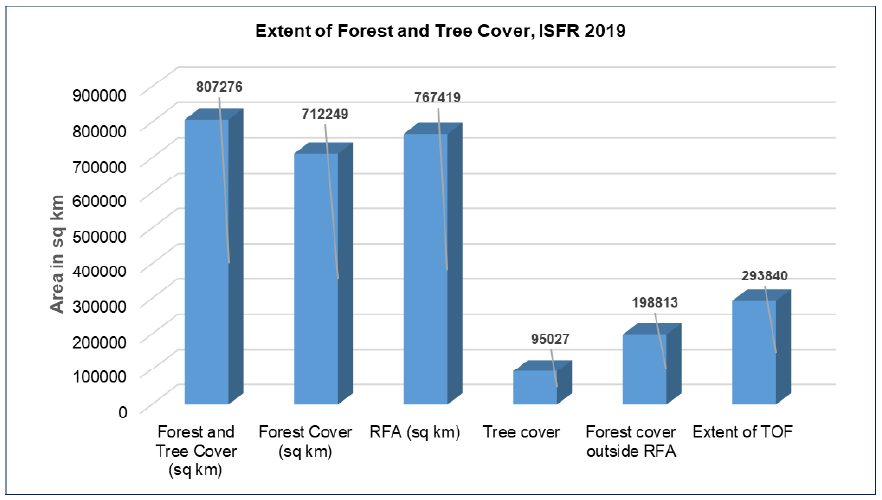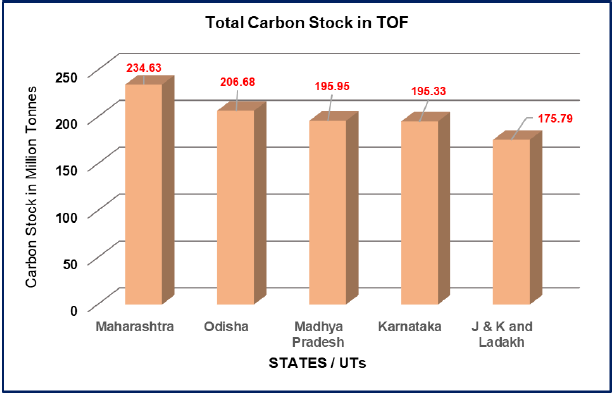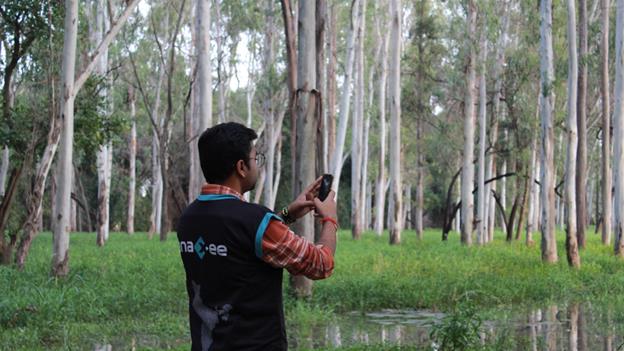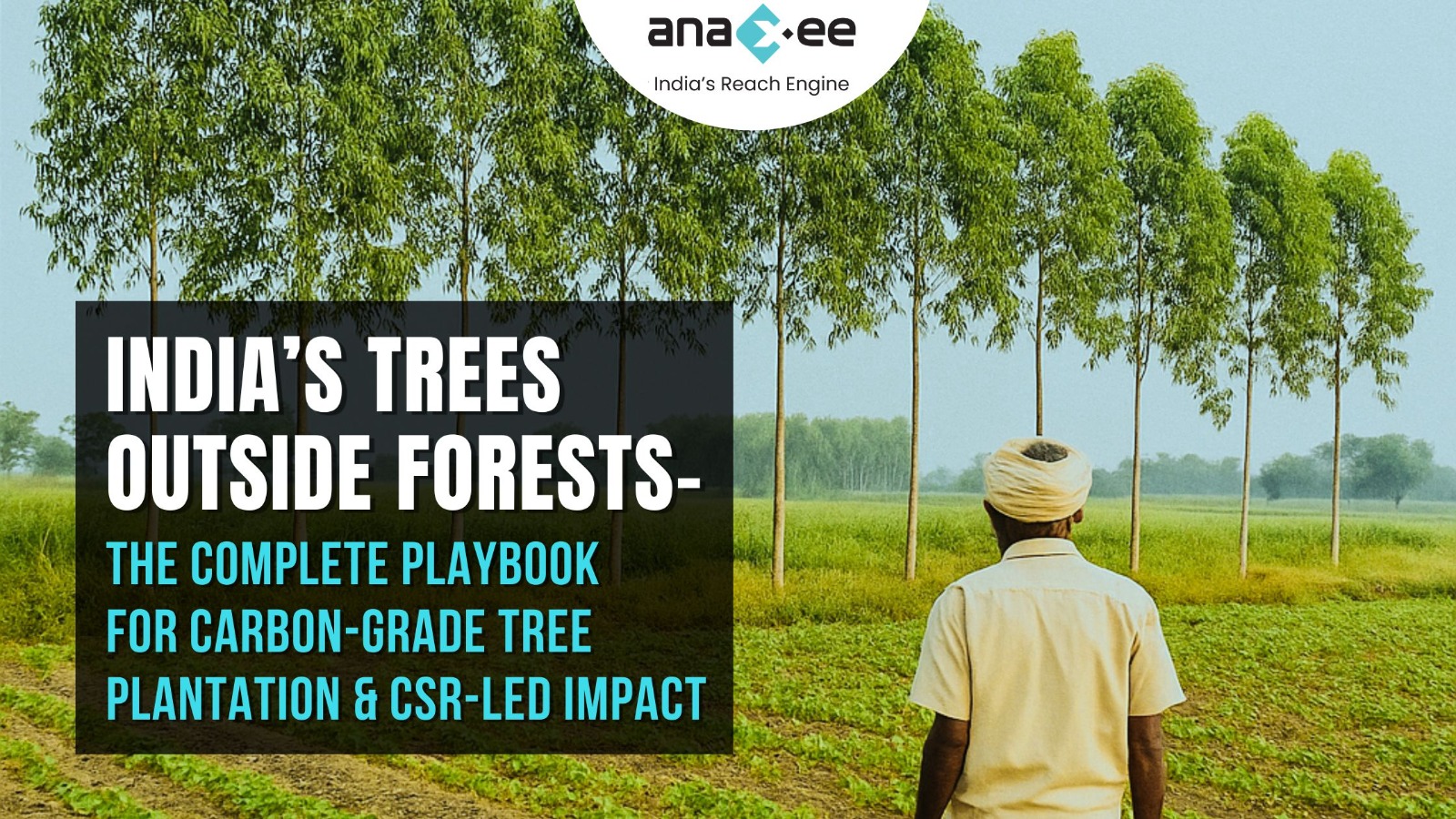2. The climate jackpot hidden in farm bunds and city parks

The latest Forest Survey of India (FSI) estimate puts total carbon stock in TOF at 2 531.8 million tonnes—roughly 38 % of all carbon held by India’s forests and tree cover combined. Five states alone account for nearly a third of that stock (see Figure 10 & 11).Parallel to climate value lies a potential annual timber yield of 85 million m³, with Maharashtra (10.60 m m³/yr), Uttar Pradesh (7.47) and Karnataka (6.28) topping the chart. Corporations looking for sustainable raw-material sourcing can therefore align revenue with restoration.
3. From village surveys to 5 × 5 km grids—why the new FSI methodology matters
FSI’s assessment design has evolved from village inventories (1991-2000) to uniform 5 × 5 km grids with a 10-year cycle. Each grid is sampled for rural and urban TOF, stratifying trees into block, linear and scattered formations. This grid-based map is decision-ready for carbon accounting because:
- Every sample plot is GPS-tagged.
- Biomass equations convert stem volume to carbon stock by density class.
- Uniform strata reduce sampling error, letting projects claim credits with confidence.
4. Defining a carbon grade tree plantation
We coin the term “carbon grade tree plantation” to describe any TOF expansion that:
- Uses FSI-accepted biomass factors for ex-ante carbon estimation;
- Aligns with at least one of the nine TOF categories (farm forestry, block plantation, roadside windbreaks, canal-side strips, rail verges, pond banks, homesteads, woodlots, “others”);
- Demonstrates monitoring compatibility with the 5 × 5 km grid inventory;
- Targets species with proven high carbon volume—e.g., Mango (12.7 % of rural TOF volume) or Neem (8.06 %).
Carbon grade plantations are thus “credit-ready by design”, shortening the verification runway and attracting finance.
5. Why private entities and CSR funds must step up
Government alone cannot green 29 million ha—yet FSI estimates 43.16 million ha of additional land is technically plantable without displacing food production. Three levers make corporates indispensable:
- Regulatory nudge: India’s Companies Act mandates 2 % of average net profit be spent on CSR. Tree planting under Schedule VII already qualifies.
- Supply-chain security: Timber demand for panels and packaging is rising; TOF offers a local, legally clear alternative to imports.
- Reputation dividends: Verified carbon credits from carbon grade tree plantations can anchor science-based net-zero claims.

Suggested CSR focus areas
| CSR lens | High-impact TOF segment | Why it works |
| Climate neutrality | Block plantations on culturable wastelands | High sequestration per hectare; easy MRV |
| Livelihoods | Farm-bund multipurpose trees | Cash + shade + fodder for smallholders |
| Urban resilience | Park & avenue retrofits | Heat-island mitigation, staff engagement days |
| Nature-positive infra | Rail & highway windbreaks | Aligns with Gati-Shakti corridors |
6. Carbon-credit pathway (data strictly from FSI)
- Baseline: Grid-level carbon stock tables offer default factors.
- Plantation: Select species from the dominant 20 list; their volume equations are published (e.g., Mangifera indica equation 13).
- Monitoring: Repeat sampling follows the same density classes (VDF/MDF/OF).
- Verification: Project carbon is the delta between new inventory and baseline—no external datasets needed.
Note: While FSI does not quote market prices, each additional tonne strengthens India’s NDC commitment; corporates can claim impact without speculating on carbon value.
7. Aligning with the Government’s TOF push
The Ministry of Environment, Forest & Climate Change is betting on TOF to deliver the 2.5-3 Gt CO₂-eq additional sink by 2030 pledged under the Paris Agreement. Private “carbon grade tree plantations” help in four ways:
- Scale: CSR capital co-finances large contiguous grids.
- Granularity: Philanthropic funds can target homesteads and scattered trees often missed by public schemes.
- Data sharing: Industry-funded inventories can feed back into FSI’s 10-year cycle, improving national estimates.
- Innovation: Tech platforms- such as Anaxee’s Digital Runners- can digitize field data collection, lowering transaction costs.

8. Action checklist for corporates
- Choose geography using Table 2 and carbon-stock maps.
- Match CSR theme (climate, rural, urban) to a TOF category.
- Design carbon grade plantation with species–site fit (see Section 4).
- Embed MRV: align plot layout with FSI grid geometry.
- Register credits under a recognized methodology (e.g., upcoming Indian Carbon Registry) once growth is measurable.
Frequently Asked Questions About TOF:
Q1. What exactly is Trees Outside Forests (TOF)?
TOF includes all trees growing outside the Recorded Forest Area- on farms, roadsides, canals, homesteads, city parks, etc. It covers formations larger than 1 ha as well as scattered individuals.
Q2. How extensive is India’s TOF?
FSI’s first nationwide assessment (ISFR 2019) pegs TOF at 29.38 million ha (8.94 % of India’s land).
Q3. What is a “carbon grade tree plantation”?
It’s a plantation designed from day one to fit FSI biomass factors, fall under one of nine recognized TOF categories, and align with grid-based monitoring—making it immediately suitable for verified carbon credits (see Section 4 above).
Q4. Which species deliver the highest carbon returns?
In rural TOF, Mango (12.7 % of total volume) and Neem (8.06 %) lead the pack. Coconut and Areca dominate in urban grids.
Q5. How does FSI calculate carbon stock?
FSI multiplies forest-cover area in each density class by per-hectare carbon factors derived from sample-plot biomass; tree-cover carbon uses crown-width-based plot data. Summing both gives total TOF carbon.
Q6. Are urban trees really counted?
Yes. Urban Frame Survey (UFS) blocks are sampled separately; Cocos nucifera tops the urban list at 17.19 % of trees.
Q7. What role can CSR budgets play?
Schedule VII of the Companies Act already lists “environmental sustainability” as an eligible activity. Funding carbon grade tree plantations satisfies CSR spend while generating measurable climate and livelihood outcomes.
Q8. How much land is still available for planting?
FSI’s NDC study (2019) identified 43.16 million ha of plantable land across wastelands, highways, canals and agroforestry corridors.
Q9. Does timber harvest conflict with carbon goals?
Not necessarily. FSI’s potential annual yield table (85 m m³ nationally) shows managed harvests; harvested wood products can continue to store carbon, and re-planting keeps the cycle climate-positive .
Q10. How can a company start today?
Identify a priority district, partner with an implementation specialist (e.g., Anaxee), map existing TOF grids, and design a plantation plan that meets carbon grade criteria. Early movers will gain both CSR recognition and a head-start on India’s emerging carbon-credit marketplace.
References
All statistics, tables and methodological details are drawn from Forest Survey of India, “Trees Outside Forest Resources in India,” Technical Information Series Vol. 2 No. 1, 2020 For more information you can connect with Anaxee at sales@anaxee-wp-aug25-wordpress.dock.anaxee.com




